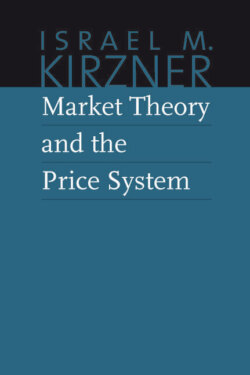Читать книгу Market Theory and the Price System - Israel M. Kirzner - Страница 42
На сайте Литреса книга снята с продажи.
MARGINAL UTILITY
ОглавлениеIn the theory of demand, the term utility is to be understood as denoting simply “significance,” in the sense set forth in the previous section. As such the utility concept is fundamental to the theory of demand and to the understanding of the determination of prices. In this and in the next chapters we use the utility concept to analyze the actions of the consumer and the way his actions are adjusted to changes in basic market data. Our discussion begins with an illustration of the notion of marginal utility as it is reflected in a simple exchange transaction between two men and then proceeds to use marginal utility as a tool in the subsequent analysis.
Imagine two men A and B. Each possesses a quantity of both fish and fruit. However, A would gladly give up some of his fish if this would secure him more fruit; B is ready to give up some of his fruit if this will increase his supply of fish. When A and B become aware of this situation, exchange ensues. We will suppose that A gives 3 lbs. of his fish to B and obtains 10 lbs. of B’s fruit in exchange. Let us restate this simple case using utility terminology, from A’s point of view.
Both fish and fruit have utility for A; A would prefer, other things being equal, to have more fish than less fish and more fruit than less fruit. However, the utility to A of the 10 lbs. of fruit that he obtains from B is greater than that of the 3 lbs. of fish that A yields in exchange. For B, of course, the case is the reverse. The utility to him of the 3 lbs. of fish that he obtains is greater than that of the 10 lbs. of fruit that he yields.
Now, it must be noticed, that when we compare for A the utilities of fruit and fish, we are not comparing the significance of fruit-in-general with that of fish-in-general. Such a comparison clearly has no meaning for a science of human action, since nobody is ever forced to choose between two such alternatives. All that is involved in the utility comparison is the utility of the quantity of fruit that A acquires with that of the quantity of fish that he yields. These are the relevant “fruit” and “fish” involved in the comparison. To emphasize this limitation, we describe the situation for A by saying that for him the marginal utility of fruit is higher than that of fish. We are able to assert that, on A’s scale of values, the marginal utility of 10 lbs. of fruit is higher than that of 3 lbs. of fish. The significance to A of the prospective 10 lbs. of additional fruit is placed higher than the significance of the 3 lbs. of fish that are to be renounced.
When the transaction has been completed, A has successfully pursued a course of action that has substituted a more valuable package for one less valuable. He was not called upon to choose between fish and fruit. He had no need to compare fish-in-general with fruit-in-general, nor even to compare all his own fish with all his own or B’s fruit. The only choice forced on A was to compare the significance of fish and fruit at the margin. At issue was the loss of some fish as compared with the gain of some fruit. What A was called upon to decide was whether the difference to him involved in the loss of the 3 lbs. of fish meant more or less to him than the difference involved in the gain of the 10 lbs. of fruit. The fact that A chose to exchange signifies that the marginal utility to him of 10 lbs. of fruit was greater than the marginal utility to him of the 3 lbs. of fish.
